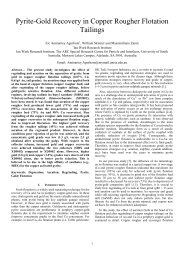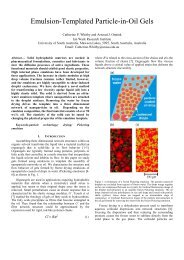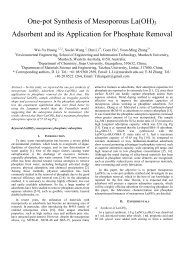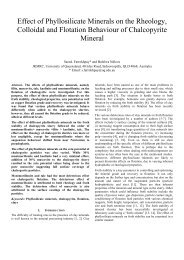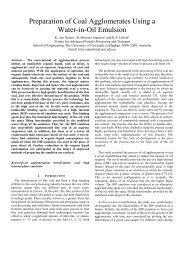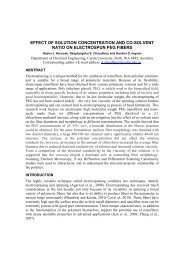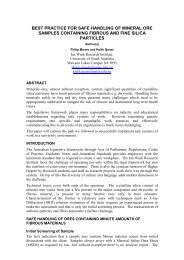a study on the calcination and sulfation behavior of limestone during ...
a study on the calcination and sulfation behavior of limestone during ...
a study on the calcination and sulfation behavior of limestone during ...
You also want an ePaper? Increase the reach of your titles
YUMPU automatically turns print PDFs into web optimized ePapers that Google loves.
Juan chen et al.<br />
Oxy-fuel combusti<strong>on</strong> is a promising technology for coal-fired power plants to mitigate<br />
its greenhouse gas emissi<strong>on</strong> in <strong>the</strong> short/medium term. In this technology, <strong>the</strong> flue gas is<br />
recirculated to mix with <strong>the</strong> air-derived pure oxygen for combusti<strong>on</strong>. The resulting CO2<br />
c<strong>on</strong>centrati<strong>on</strong> in flue gas can reach up to 95%. Since a large porti<strong>on</strong> <strong>of</strong> flue gas is<br />
recycled, <strong>the</strong> gaseous impurities such as SO2/SO3 within it can gradually accumulate in<br />
a furnace, which in turn potentially causes extra fouling <strong>and</strong> tube corrosi<strong>on</strong> problems<br />
through <strong>the</strong> depositi<strong>on</strong> <strong>of</strong> sulfates, as well as affects <strong>the</strong> purity <strong>of</strong> <strong>the</strong> CO2 which is<br />
eventually sequestrated. To solve <strong>the</strong>se problems, an efficient capture <strong>of</strong> SO2 for flue<br />
gas clean-up is pivotal for an oxy-fuel system.<br />
In-furnace capture <strong>of</strong> SO2 through <strong>the</strong> use <strong>of</strong> limest<strong>on</strong>e is a promisingly cost-effective<br />
manner for flue-gas clean-up. As has been c<strong>on</strong>firmed for <strong>the</strong> c<strong>on</strong>venti<strong>on</strong>al air<br />
combusti<strong>on</strong>, <strong>the</strong> sulfur removal <strong>of</strong> limest<strong>on</strong>e involves two c<strong>on</strong>secutive steps: calcinati<strong>on</strong><br />
<strong>of</strong> limest<strong>on</strong>e <strong>and</strong> sulfati<strong>on</strong> <strong>of</strong> calcium oxide, (Borgwardt 1970) according to<br />
Calcinatio n : CaCO3<br />
→ CaO + CO2<br />
(1)<br />
Sulfati<strong>on</strong> : CaO + SO2<br />
+ O2<br />
→ CaSO4<br />
(2)<br />
Direct Sulfati<strong>on</strong> : CaCO + SO + 0.<br />
5O<br />
→ CaSO + CO<br />
(3)<br />
3<br />
2<br />
The calcinati<strong>on</strong> <strong>of</strong> CaCO3 by reacti<strong>on</strong> (1) is affected by two factors, CO2 partial<br />
pressure <strong>and</strong> particle temperature. The high CO2 partial pressure in an oxy-fuel furnace<br />
is expected to play a negative role. However, it is unclear if <strong>the</strong> increase in particle<br />
temperature through radiative heat transfer from coal flame will <strong>of</strong>fset this negative role.<br />
Regarding <strong>the</strong> sulfati<strong>on</strong> reacti<strong>on</strong>, apart from reacti<strong>on</strong> (2), <strong>the</strong> direct sulfati<strong>on</strong> <strong>of</strong><br />
limest<strong>on</strong>e according to reacti<strong>on</strong> (3) is also c<strong>on</strong>siderable for sulfur capture, in particular<br />
<strong>during</strong> oxy-fuel combusti<strong>on</strong>. A generalised underst<strong>and</strong>ing has yet to be achieved in <strong>the</strong><br />
literature. Liu <strong>and</strong> his co-workers (2000) c<strong>on</strong>sidered that, as <strong>the</strong> sintering extent <strong>of</strong><br />
limest<strong>on</strong>e in CO2 is decreased substantially, <strong>the</strong> direct sulfati<strong>on</strong> <strong>of</strong> limest<strong>on</strong>e exhibits a<br />
comparable rate to that <strong>of</strong> <strong>the</strong> sulfati<strong>on</strong> reacti<strong>on</strong> <strong>of</strong> calcium oxide in O2/CO2. Fuertes et<br />
al (1994) <strong>and</strong> Snow et al (1988) suggested <strong>the</strong> kinetic c<strong>on</strong>trol <strong>and</strong> fast diffusi<strong>on</strong> <strong>of</strong> gases<br />
for reacti<strong>on</strong> (3). Our previous result also c<strong>on</strong>firmed <strong>the</strong> large potential for reacti<strong>on</strong> (3)<br />
in O2/CO2 under certain c<strong>on</strong>diti<strong>on</strong>s (Chen et al., 2011). In c<strong>on</strong>trast, Iisa <strong>and</strong> Hupa (1990)<br />
hypo<strong>the</strong>sized <strong>the</strong> diffusi<strong>on</strong> limit for <strong>the</strong> directi<strong>on</strong> sulfati<strong>on</strong> <strong>of</strong> limest<strong>on</strong>e, <strong>and</strong> some o<strong>the</strong>r<br />
researchers also proposed <strong>the</strong> comparable significance <strong>of</strong> reacti<strong>on</strong> c<strong>on</strong>trol <strong>and</strong><br />
diffusivity limit (Hajaligol et al. 1988; Iisa <strong>and</strong> Hupa, 1992). Moreover, <strong>the</strong> influence <strong>of</strong><br />
<strong>the</strong> coal-bound inorganic metals <strong>on</strong> <strong>the</strong> <strong>behavior</strong> <strong>of</strong> limest<strong>on</strong>e in O2/CO2 mixture has not<br />
yet been studied. At <strong>the</strong> typical pulverized coal-fired temperatures, <strong>the</strong> interacti<strong>on</strong><br />
between calcium <strong>and</strong> alumina/silic<strong>on</strong> for <strong>the</strong> formati<strong>on</strong> <strong>of</strong> molten eutectics is a<br />
significant cause inhibiting <strong>the</strong> sulfati<strong>on</strong> capture efficiency in air (Zhang et al. 2002).<br />
The present <str<strong>on</strong>g>study</str<strong>on</strong>g> aims to address <strong>the</strong>se knowledge gaps to clarify <strong>the</strong> transformati<strong>on</strong><br />
<strong>behavior</strong> <strong>of</strong> CaCO3 in oxy-fuel combusti<strong>on</strong>. In particular, <strong>the</strong> interacti<strong>on</strong> <strong>of</strong> coal-bound<br />
metals with limest<strong>on</strong>e has been elucidated in detail, through <strong>the</strong> combusti<strong>on</strong> <strong>of</strong><br />
limest<strong>on</strong>e mixed with a low-rank lignite at different mass ratios. The lignite used is<br />
Victorian brown coal rich in organically bound metals. Its combusti<strong>on</strong> at high<br />
temperature is expected to deliver plenty <strong>of</strong> fine <strong>and</strong> even ultra-fine ash particles which<br />
2<br />
4<br />
2<br />
2



